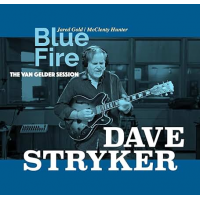Home » Jazz Articles » Album Review » Tony DePaolis: The Contemporary Dynamic
Tony DePaolis: The Contemporary Dynamic
Take everything you know about what a debut record should and should not be. Now promptly throw those ideas into oncoming traffic and don't look back.
Young Pittsburgh bassist Tony DePaolis has redefined the boundaries of the all-important debut record with The Contemporary Dynamic. It's a concept album. It's a double album. Its personnel list is thirty-six musicians deep. The Contemporary Dynamic isn't just ambitious; it is absurdly ambitious.
The concept behind DePaolis's album is deceptively simple: a commentary on an average week in the life of a Pittsburgh jazz musician. "The concept arose from the reality of my professional experience of the past five years," says DePaolis. "To be a young jazz musician in this day and age, you live in six different eras at once. Most of the colleagues I work with also navigate a contemporary dynamic of times, styles, and regions." The bassist leaves few stones unturned in terms of musical exploration. While some musicians might find the weight of a double album too cumbersome, the young bassist uses every second of space to explore the avant-garde, straight-ahead jazz, tangos, Brazilian pop, R&B, and everything in-between. If it sounds intimidating, the incredibly meticulous DePaolis reduces that dramatic equation down to a popular Charles Mingus quote: "Someday all good music will return from its assorted labels which inhibit it."
Though DePaolis's playing is enjoyable, it does not take center stage on this record, nor is it supposed to. It would be impossible to talk about this record without acknowledging the bassist's writing chops. Half of the tunes on this album are DePaolis originals. He also writes from a bassist's perspective, meaning he writes to bring out the natural abilities of the players surrounding him. Listeners can toss around terms like "grandiose" and "aggressive" but perhaps the most important adjective to describe this record is "selfless." DePaolis takes a backseat during most of these tracks to allow heavy-hitters like Roger Humphries and Jimmy Ponder to swing for the fences. The record also serves as a first-hand account of the staggering talent of Pittsburgh's old guard juxtaposed with the possibilities of DePaolis's generation.
The titular first track is a meticulously constructed homage to hard bop. The DePaolis original serves as an effective opener because it firmly establishes the diverse, intense trajectory of the album. DePaolis and Michael Thomas's arrangement packs an invigorating punch in the vein of Lenny White's "L's Bop." The track is also the highpoint of DePaolis's bass playing. He leads the charge supported by Chris Hemingway, Jacob Yoffee, Sean Jones, Michael Murray, and James Johnson III. DePaolis immediately steps away from hard bop with the tango track "Tonald the Destroyer," the bassist's most intricate writing on the record. This romantic tune opens with the whine of Joe Arnold's violin punctuated by Murray's polished accordion. Colter Harper's guitar accompaniment and DePaolis's simple playing give this incredibly complex tune its structure.
As one of the most in-demand players in Pittsburgh, DePaolis regularly performs with Brazilian singer Kenia. DePaolis, Murray, drummer Thomas Wendt, and percussionist Lucas Ashby are attuned students of the Brazilian pop tradition. All four display their chops on two different versions of Gilberto Gil's "Bahia de Todas as Contas." The instrumental performance on disc one features DePaolis on electric bass, Colter Harper on guitar, Ashby on percussion, and Wendt on drums, while the vocal performance features Kenia's signature sound backed by guitarist Eric Susoeff. Ashby is an arsenal of percussive instruments. His pandeiro technique is particularly tight and he works well alongside Wendt, whose playing is characteristically full-bodied.
DePaolis's arrangement of "Blue Skies," featuring his father Don DePaolis on piano, Jimmy Ponder on guitar, and Roger Humphries on drums, is one of many instances on this record where the bassist successfully bridges the generational divide. The 27-year-old DePaolis does not sound out-of-place, and for good reason: the three elder statesmen have collaborated countless times before, and this particular quartet has made several appearances together since 2008 as the Legends Quartet. DePaolis has referred to Ponder as a mentor and the guitarist's impact is exceedingly clear on this particular track. The bassist mimics Ponder's playing note-for-note in his solo but the influence goes well beyond solo structure, seeping into everything DePaolis does on this track.
"Willow Tree," written by DePaolis and Carolyn Perteete, opens with a dreamy introduction by Kenny Peagler on Fender Rhodes piano and Daru Jones on drums. DePaolis and Perteete have previously collaborated on Gemini's Evermore in 2006. Perteete simultaneously flexes her signature songwriting muscles and showcases her versatile vocal chops. There is nothing particularly complex about this R&B tune yet its hypnotic vibe is more than enough to capture the listener's attention. Perteete's multi-tracked vocals are punctuated by Johnson's cross sticks and guitarist Chris Parker's rhythmic downstrokes. The song is reprised as "What You Feel" on the second half of the record and features vocalist Gene Stovall, one of the most versatile singers to come out of this generation of Pittsburgh's musicians. A soulful powerhouse, Stovall's sound and lyrics differ significantly from Peteete's, but taken together these two tracks create a full, sensual narrative that stands apart from the rest of the record's content.
DePaolis's appreciation of all things weird and wonderful reveals itself at a number of junctures on this record but is perhaps most apparent on "Cowell Resonance," the record's last solo piano tune. "Cowell Resonance" is composed and performed by DePaolis in the style of innovative classical composer Henry Cowell and as a tribute to Cowell's composition, "Sinister Resonance." Though most of the more eclectic tracks featured on The Contemporary Dynamic have an ironically morbid humor, "Cowell Resonance" is a distinctly dark piece, made all the more striking by the recording space at Heid Pro Audio.
"Whims of James," a nod to McCoy Tyner's "Four By Five," opens with James Johnson's gentle cymbal crash. He leans heartily into the kit, extracting every bit of music possible while Chris Hemingway and Jacob Yoffee support Sean Jones's lead trumpet. DePaolis and Murray work together in a manner that is as interesting as it is unnerving. The two play with a deep, unspoken understanding that translates well on every track, but of particular note here. DePaolis's solo blends into Murray's seamlessly. It is a precise maneuver yet one that is almost certainly subconscious—the product of mileage that seems to span lifetimes and light-years.
Regarding his original composition "Legacy," DePaolis rhetorically asks "Who doesn't write avant-garde jazz ballads for their parents?" Sheepishness aside, DePaolis paints a landscape with anxious, nostalgic colors. The piece swings almost violently between lethargy and manic energy. Alex Peck's light cymbal rolls, Bryan Connell's cold, bright lines, and Yoffee's warmly encompassing sound usher in the more cathartic parts of the composition, while the more frantic sections are punctuated by wailing saxophones and Murray's erratic flourishes. Though DePaolis sets and maintains the structure on upright bass, his playing is just as exploratory as that of his colleagues.
DePaolis enlists the help of reedman Paul Cosentino on clarinet, pianist Daniel May, and guitarist Joe Negri for his endearing rendition of "East Side of Heaven," which DePaolis dedicates to the late vocalist Sandy Staley. DePaolis pulls double-duty as vocalist and bassist here. With his soft, warm voice, it's no surprise that he counts Chet Baker among his influences. That softness is the foundation of this track, and the absence of percussion grants Negri an immense amount of space. Nothing he plays is particularly complex but his comping brings out the warmth of Consentino's upper register tone.
Jimmy Ponder announces his return on this record in his characteristically, china shop-shattering way on "Ponder's X-Mas Rap." The live recording , taken during a December gig at Pittsburgh's once-historic James Street Speakeasy, opens with Ponder's rumbling laughter directly into the microphone. He spends the duration of the track discussing the meaning of life with the audience. Without revealing too much about this cathartic experiment, the guitarist declares that man's goal should be to live and live righteously. "Pay attention!" he bellows, "because if you don't, you're gonna' be in chaos!" There's a brief pause before he dials it back down and wishes everyone peace, love, and a Merry Christmas. Then, he turns towards DePaolis and asks him, "Now whatcha' wanna' do?" Ponder's inquiry is immediately answered by DePaolis's arrangement of "Silent Night," featuring Sean Jones on lead trumpet. The eerie arrangement is accented by the whisper of Jones clearing his spit valve in its final seconds. There are moments of unintentional magic on this record, and this is one of them. Its inclusion is intentional: DePaolis, meticulous and deliberate, leaves nothing to chance.
The Contemporary Dynamic is the fine-tuned mechanism DePaolis uses to pay homage to his musical heroes and the world they have created for him. Chief among Tony DePaolis's influences is his father, Pittsburgh pianist and composer Don DePaolis, who plays on the record and contributes several of his own compositions. The younger DePaolis obviously draws inspiration from his father's writing but his originality stands formidably on a plain all its own. "Not Lucid [Zele]" and "The Curse, Of Course" are Don DePaolis's pieces but his son's arrangement of "Folkprance" makes one of the biggest statements on the record. The younger DePaolis breathes new life into the piece with an arrangement featuring Murray and Yoffee. Murray's playing is immediately recognizable in his entrenched, melancholic tone. He shines brightest on this track, providing an arrestingly sober counterpoint to the otherwise warm levity of the tune. Conversely, Yoffee's bright soprano organically balances this deeply heartfelt, invigorating composition.
DePaolis brings his extended tribute to his parents full circle with the inclusion of "God Bless the Child," featuring his mother Kathy Connor on vocals and his father on Fender Rhodes piano. Connor is a seasoned veteran of the '70s lounge-singing circuit, and delivers with a conversational rhythm as confident as it is distinct. Don DePaolis's playing is gentle if a little subdued. The track is inescapably sentimental but the indulgence is certainly worth its place on the record. Many of Pittsburgh's most talented up-and-comers got their earliest gigs performing with their parents, and this relationship speaks to the overall intimacy of the city's local jazz culture.
"Waiting for an Answer" is another high point in terms of DePaolis's songwriting voice. It is listed near the end of the record and serves as an effective survey of the sheer caliber of musicianship included on The Contemporary Dynamic. James Johnson and George Jones lock into the groove right out of the gate on drums and conga, respectively. This is perhaps the best example of DePaolis's selfless playing and writing on the record. "Any player will do" is not a phrase in DePaolis's lexicon and this track was written specifically with Jacob Yoffee and Sean Jones in mind. Each solo is gentle, but the track escalates to a fever pitch around the ten-minute mark. DePaolis steadily keeps the course, vesting immense power in the players he has hand-chosen to surround himself with. The bassist digs in with the support of Johnson, Murray, and George Jones, while Yoffee and Sean Jones escalate the piece to a place of blood-pumping pseudo-insanity.
The album concludes with Leonard Bernstein's "Lucky To Be Me." This great Broadway tune feels altogether new with the treatment it receives from DePaolis, Murray, and Johnson. What could be a safe throwaway tune instead becomes something remarkable: Murray falls back heavily on his knowledge of Bill Evans's style, and puts down one of his strongest, most morose performances on the record. Johnson's brushwork is impeccable and DePaolis's comping is tastefully reserved but this track belongs to Michael Murray. Much like everything else on this record, there is nothing contrived about it. There is no gimmick. "Lucky To Be Me" is a time and place on the record where three musicians with history sit down and play something beautiful.
The Contemporary Dynamic is an emotional journey filled with nostalgia, bewilderment, and jubilation. It is a shrine to the elders of the Pittsburgh jazz scene, living and dead, and is a deeply intimate snapshot that captures the life of a young jazz musician. Call the music whatever genre, or nothing at all. The Contemporary Dynamic remains unbound by genre, terminology, and by its very concept. I wish you luck in reconciling The Contemporary Dynamic with everything you know about what a debut record should and should not be. Wherever Tony DePaolis is headed next, it won't be boring.
Track Listing
DISC ONE: The Contemporary Dynamic; Tonald The Destroyer; Bahia De Todas As Contas (Instrumental); Blue Skies; Willow Tree; That Which Is Coming; Proletarian Chicks in Bondage; Whims of James; Legacy. Talkin’ In My Ear Now; Caruso’s Favorite Bars In Rome; East Side of Heaven; Sphinx Riddle; Ponder’s X-Mas Rap; Silent Night. DISC TWO: Bahia De Todas As Contas (Vocal); Not Lucid (Zele); Tell Me Where You Goin’; Cowell Resonance; Folkprance; God Bless The Child; Music Always; Waiting For An Answer; What You Feel (Willow Tree Reprise); The Curse, Of Course; The Ruins; Lucky To Be Me
Personnel
Tony DePaolis
bassTony DePaolis: bass, electric bass, piano, vocals, Rhodes; James Johnson III: drums; Thomas Wendt: drums; Roger Humphries: drums; Greg Humphries: drums; Alex Peck: drums; George Jones: congas; Miguel Sague: congas; Lucas Ashby: percussion; Howie Alexander: organ, piano; Michael Murray: piano, accordion, Rhodes; Kenny Peagler: Rhodes; Don DePaolis: piano; Daniel May: piano; Jimmy Ponder: guitar; Joe Negri: guitar; Colter Harper: guitar; Chris Parker: guitar; Eric Susoeff: guitar; Andy Bianco: guitar; Joe Arnold: violin; Sean Jones: trumpet; James Moore: trumpet; Jacob Yoffee: tenor sax, alto sax; Chris Hemingway: alto sax; Bryan Connell: tenor sax; Paul Cosentino; clarinet: Jay Willis: tenor sax; Kathy Connor: vocals; Kenia: vocals; Carolyn Perteete: vocals; Gene Stovall: vocals; Dr. Strange K: vocals; Thelonious Stretch: MC
Album information
Title: The Contemporary Dynamic | Year Released: 2009 | Record Label: Self Produced
Tags
PREVIOUS / NEXT
Support All About Jazz
 All About Jazz has been a pillar of jazz since 1995, championing it as an art form and, more importantly, supporting the musicians who make it. Our enduring commitment has made "AAJ" one of the most culturally important websites of its kind, read by hundreds of thousands of fans, musicians and industry figures every month.
All About Jazz has been a pillar of jazz since 1995, championing it as an art form and, more importantly, supporting the musicians who make it. Our enduring commitment has made "AAJ" one of the most culturally important websites of its kind, read by hundreds of thousands of fans, musicians and industry figures every month.



















